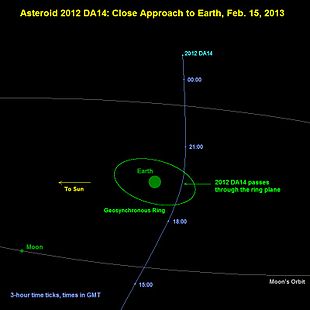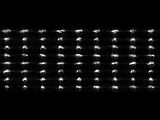(367943) Duende
|
Asteroid (367943) Duende |
|
|---|---|

|
|
| Flyby on February 15, 2013 | |
| Properties of the orbit ( animation ) | |
| Orbit type | Aten type |
| Major semi-axis | 0.9103 AU |
| eccentricity | 0.0893 |
| Perihelion - aphelion | 0.8290 AU - 0.9916 AU |
| Inclination of the orbit plane | 11.6085 ° |
| Length of the ascending node | 146.9746 ° |
| Argument of the periapsis | 195.5775 ° |
| Time of passage of the perihelion | Template: FormatDate : Not a valid ISO date! |
| Sidereal period of rotation | 317 d 5 h |
| Mean orbital velocity | 31.15 km / s |
| Physical Properties | |
| Medium diameter | approx. 40 m |
| Rotation period | 9.1 h |
| Absolute brightness | 24.1 mag |
| history | |
| Explorer | Observatorio Astronómico de La Sagra |
| Date of discovery | February 23, 2012 |
| Another name | 2012 DA14 |
| Source: Unless otherwise stated, the data comes from JPL Small-Body Database Browser . The affiliation to an asteroid family is automatically determined from the AstDyS-2 database . Please also note the note on asteroid items. | |
(367943) Duende is a near-Earth asteroid of the Aten type . It was discovered on February 23, 2012 at the Observatorio Astronómico de La Sagra in Spain . On the basis of rough estimates of brightness and reflectivity , the diameter was estimated to be a few dozen meters.
The asteroid was named on November 17, 2012 after the Spanish name for goblins , previously it was known under the provisional designation 2012 DA 14 .
Approximation February 2013
(367943) Duende came close to Earth on February 15, 2013 to about 27,700 km, which was within the orbit of the geostationary satellites . The asteroid reached an apparent magnitude of 7.4 mag and was therefore not visible to the naked eye. It reached its closest distance to Earth at 20:24 ( CET ) over Sumatra and the eastern Indian Ocean . At the time of its closest approach, the asteroid's position in the sky was shifting about 0.8 degrees per minute. The close encounter with Earth changed the asteroid's orbit. He went from the Apollo type to the Aten type .
Radar observations were planned for the time shortly after the asteroid's closest approach . At the Goldstone Observatory , measurements were carried out with the 70-meter antenna with a resolution of less than four meters per pixel. First data show an elongated shape of the celestial body.
Due to a meteor impact that took place in Russia on the same day , the media initially speculated about a connection with the flyby of (367943) Duende. According to the European Space Agency , however, this is excluded due to the different orbits of the two objects and the short time difference is random.
Section of the orbit of DA 14 around the sun and the approach to earth in 2013
See also
Web links
- Video: Recordings of a flyby , February 2013
- (367943) Duende in the Small-Body Database of the Jet Propulsion Laboratory (English).
- spaceweather.com archive 24.012.2012
- NASA Record Setting Asteroid Flyby , Jan 28, 2013
- Stars and space asteroid 2012 DA14 scrapes past Earth , February 6, 2013
- heavens-above.com Asteroid 2012 DA14 flyby Calculates overflight map for personal observation location
- NASA: Eyes on the Solar System Asteroid 2012 DA14 Earth Flyby
- Asteroid 2012 DA14 photos from southern Switzerland from February 15, 2013
Individual evidence
- ↑ Press release Planetarium Berlin ( Memento from March 5, 2016 in the Internet Archive ) (PDF; 16 kB)
- ↑ I. Wlodarczy: The potentially dangerous asteroid 2012 DA14 . Monthly Notices of the Royal Astronomical Society. Volume 427, Issue 2, pages 1175–1181, December 2012. Quotation: For H = 24.377 and an albedo of 0.20 for S-type and 0.04 for C-type asteroids, we find the diameter of 2012 DA14 to be between 40 and 89 m, respectively. The JPL NASA lists H = 24.377 and D = 45 m and the NEODyS lists H = 24.4 with 30 <D <80 m, respectively, for an albedo of 0.15. doi : 10.1111 / j.1365-2966.2012.22034.x
- ^ NASA report of February 4, 2013
- ↑ a b 2012 DA14 Goldstone Radar Observations Planning , last update: February 14, 2013, accessed on February 15, 2013
- ↑ NASA Releases Radar Movie of Asteroid 2012 DA14 ; Early Radar Observations of Asteroid 2012 DA14 jpl.nasa.gov, accessed February 21, 2013
- ^ ESA announcement on the meteor near Chelyabinsk , accessed on February 21, 2013



